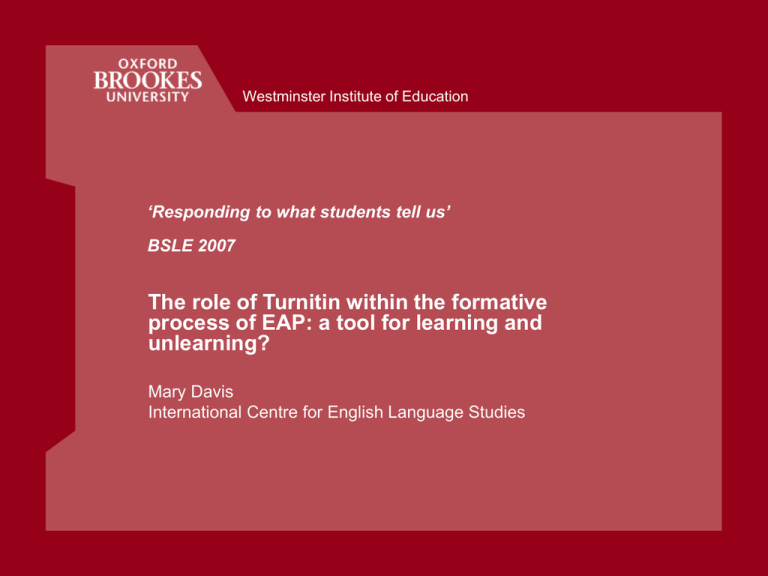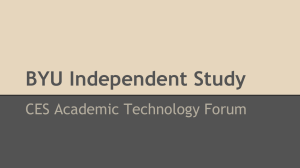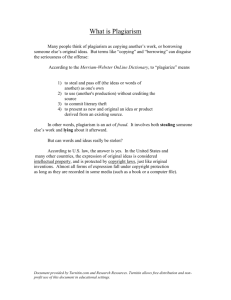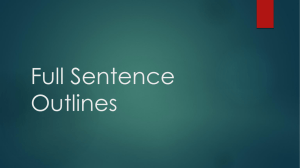'Responding to what students tell us' BSLE 2007
advertisement

Westminster Institute of Education ‘Responding to what students tell us’ BSLE 2007 The role of Turnitin within the formative process of EAP: a tool for learning and unlearning? Mary Davis International Centre for English Language Studies Setting and rationale for this study • Extended writing project module on the pre-Master’s diploma for international students • This module is seen as the most important, with a 3,000 word mini-dissertation • Students need to assimilate UK academic conventions and “unlearn” old ones • In the 2005 feedback questionnaire at the end of the module, students stated that if they took the module again, they would want: • To improve their writing more between drafts • To learn more about using sources Westminster Institute of Education Challenges for international students • Hayes and Introna (2005:213) found that “plagiarist practices are often the outcome of many complex and culturally situated influences” • East (2002:3) says many international students “come from educational cultures where copying is an expected learning practice”. • Handa and Power (2005:77) “many students end up plagiarising because they do not fully understand the academic requirements of their new academic culture” • Carroll and Appleton (2001) highlight the difficulty for students as “setting aside previously successful strategies and learning new ones”. Carroll (2005) recommends detecting, deterring and dealing with plagiarism in a culturally sensitive way. • Bull et al (2001:5) remind that “the most common trigger that arouses academics’ suspicions of plagiarism in assignments is a change of writing style within a text”. Westminster Institute of Education Method • Turnitin included for the first time in the 2006 run of the module. • Part of plagiarism education programme which included at least 6 hours’ instruction, focus of online discussions, handbook selfstudy exercises, library guidelines, institutional warnings. • Written task carefully designed to deter plagiarism – based on individual research question, guided by tutor to be evaluative, not descriptive – thus following principles for deterring plagiarism (Carroll and Appleton 2001). • First drafts submitted to Turnitin (in week 9 of 12 week semester), originality reports generated, and used in tutorial feedback. No marks given and no penalties, even if clear plagiarism at this stage. Open discussion of sources. • Follow up analysis of perceived improvements in final draft, student evaluations through questionnaires and focus group, to assess success (2006-2007) Westminster Institute of Education Student A – First Draft Westminster Institute of Education Student A – Final Draft Westminster Institute of Education Student B – First Draft Westminster Institute of Education Student B – Final Draft Westminster Institute of Education Interpreting percentages in Turnitin • “Which percentage means good or bad?” • “Does 25% mean my work is 25% plagiarism?” • Barrett and Malcolm (2006) suggest a threshold of 15%. • In this study, interpretation of results suggest that the percentages are not clear cut, and it does not seem useful to establish a threshold. • Despite general perceptions of green, not all green results were safe, while some yellow results did not indicate plagiarism, although they did indicate over-reliance on sources. • Peacock et al (2006) argued that the interpretation of Turnitin needed to be facilitated by clear guidelines and training for tutors, in order to give good feedback to students. Westminster Institute of Education Helping with citation • • • • • • 73% in 2007, 71% in 2006 stated that they thought Turnitin was useful for learning to write citations accurately: “We don’t know about citation before we come here. In my country, we need to use professional language in our writing, otherwise it does not sound right. We don’t need to put the author, just at the end.” “Doing citations accurately is not easy for foreign students. We really need a useful tool that could help.” “The software helped me to be more cautious about citation” “For me, I will never ever forget about efficient citations according to the first experience of Turnitin, and especially for my dissertation, I keep it in mind that I should understand every knowledge in depth in order to avoid plagiarism” “Sometimes we make a mistake and don’t use citation or not correctly… this way gives us a second chance” Westminster Institute of Education Avoiding over-reliance on some sources • 85% in 06, 82% in 07 thought that Turntin was useful for avoiding over-reliance on one or certain sources: • “It helps my work lead to the right track. I would like to use it for to find out over-relianced sources because I tend to cite many points from one source” • “Turnitin is useful for avoiding over-reliance.. because there is a sort of pressure, from the software to make aware of use of sources” • “It helps a lot to avoid over-reliance… because it shows you the percentage, like this source is 5%, in colour”. Westminster Institute of Education Thinking about appropriate paraphrasing • 71% from 06, 64% from 07 thought Turnitin was useful for thinking about appropriate paraphrasing: • “International students are not good at paraphrasing. So Turnitin is useful for students thinking about it.” • “Turnitin was useful for thinking about paraphrasing.. Well, that is what the software is all about.” • “It highlights some part of bad paraphrasing, then we can correct it” • “It doesn’t tell us which part or paraphrasing is good – we get that from the teacher.” Westminster Institute of Education Avoiding plagiarism • 71% in 06, 73% in 07 thought it was useful for understanding how to avoid plagiarism: • “It is very helpful to remind students be careful about plagiarism” • “The software shows your mistakes.. Then we can correct them. At the end, when we submit the final draft, we don’t want to fail.” • “I would like to use it again because sometimes we do plagiarism without noticing it.” • “ I think checking plagiarism by computer is good because all students are trying to avoid plagiarism” • “In my country, I can copy a whole assignment, without writing a word, and get an A. Here it is different, and at the beginning, I didn’t know anything. Turnitin helped correct a lot my mistakes.” Westminster Institute of Education Tutor guidance or self-access? • “I would like my own access to Turnitin” • “It would be good if we could submit 3 times, then I think I would get it right” • “If I had my own access, I think I would spend a long time submitting again and again to get it right” • “I think it would be very helpful if students could use it. However, it may help students to do well-organized plagiarism.” • “Turnitin is for tutors checking for plagiarism. I don’t understand it. Maybe we need a guide for it.” Westminster Institute of Education Drawbacks of Turnitin • 1. Problems with sources Different to those students used, not accessible, not on the database because less popular discipline (Barrett and Malcolm 2006) or no e-book available. • 2. Problems with correct citations All other authors’ words included with originality report. • 3. More work for tutors Time consuming – administering, uploading, checking, discussing (Sutherland-Smith and Carr 2005) Westminster Institute of Education Conclusions Students wanted: • To improve their writing more between drafts • To learn more about using sources Students improved: • in their use of accurate citation • in their reference to a more appropriate number of sources • in appropriate paraphrasing • in understanding how to avoid plagiarism. Students evaluated this use of Turnitin with first drafts as: • useful for this assignment • helpful in understanding more about plagiarism. Westminster Institute of Education Recommendations 1. Turnitin can be used with first drafts before assessment for useful learning opportunities in plagiarism education. 2. Turnitin can be more effectively used with tutor guidance to ensure correct interpretation of originality reports. 3. Turnitin should not be seen as a substitute for other feedback or a solution in itself, but as a tool to support learning. In this way, it becomes part of an integrated approach to plagiarism education, as recommended in the JISC-PAS guidelines for good practice (Carroll 2002). 4. Further exploitation is recommended. Planned research will include a checklist of specific areas to discuss and note progress on: appropriate paraphrasing, accurate copying of direct quotations, accurate in-text citation, discussion of ownership of words and ideas, discussion of the appropriate number of sources and how much to use them. Further evaluation will also be collected from tutors. Westminster Institute of Education Bibliography • • • • • • Barrett, R. and Malcolm, J. (2006). Embedding plagiarism education in the assessment process. International Journal for Educational Integrity, 2 (2), pp.3845. Bull, J., Coughlin, E., Collins, C. and Sharp, D. (2001). Technical review of plagiarism detection software report. (online) Joint Information Systems Committee, pp.1-36, accessed on 9/1/2007 from http://www.jisc.ac.uk/uploaded_documents/luton.pdf Carroll, J. (2005). “Deterring, detecting and dealing with plagiarism”, a brief paper for Brookes staff for Academic Integrity week, accessed 4/1/07 from http://www.brookes.ac.uk/services/ocsd/5_research/jude.html Carroll, J. (2002). A handbook for deterring plagiarism in higher education. Oxford: Oxford Centre for Staff and Learning Development, Oxford Brookes University. Carroll, J. and Appleton, J. (2001). ‘Plagiarism: A Good Practice Guide’, Oxford Brookes University Guide Series [on-line] Joint Information Systems Committee. Accessed on 10/1/2007 from http://www.jiscpas.ac.uk/apppage.cgi?USERPAGE=6202 East, J. (2005). Proper acknowledgement? Journal of University Teaching and Learning Practice, 2 (3a) pp.1-11, accessed 14/9/2006 from http://jutlp.uow.edu.au/2005_v02_i03a/east005.html Westminster Institute of Education Bibliography • • • • • Handa, N. and Power, C. (2005). “Land and discover! A case study investigating the cultural context of plagiarism.” Journal of University Teaching and Learning Practice 2 (3b) pp.64-86. Hayes, N. and Introna, L.D. (2005). “Cultural values, plagiarism, and fairness: when plagiarism gets in the way of learning.” Ethics and Behaviour 15 (3) pp.213-231. Howard, R.M. (2000). “Sexuality, textuality: the cultural work of plagiarism”. College English, Urbana. 62 (4) pp.473-491. Peacock, S., Sharp, J. and Anderson, S. (2006). Pickup a plagiarism practice? A holistic approach to deploying TurnitinUK as a sustainable driver in altering institutional plagiarism practice. Centre for Academic Practice, Queen Margaret University College, Edinburgh. Paper presented at JISC International Plagiarism Conference, Newcastle, 19-21 June 2006. Sutherland-Smith, W. and Carr, R. (2005). Turnitin.com: teacher’s perspectives of anti-plagiarism software in raising issues of educational integrity. Journal of University Teaching and Learning Practice, 2 (3b) pp.94-101. Turnitin (2007). Plagiarism prevention. Accessed on 4/1/2007 from http://www.turnitin.com/static/home.html Westminster Institute of Education





